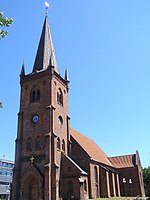The Wave (Vejle)
Apartment buildings in DenmarkBuildings and structures in Vejle MunicipalityVejle

Bølgen (Danish "The Wave") is a modern residential building complex by the Skyttehus bay in Vejle, Denmark. It is inspired by the Sydney Opera House by Danish architect Jørn Utzon and the hilly landscape around Vejle Fjord.The Wave in Vejle is designed by Henning Larsen Architects and contains ultimately 105 luxury apartments distributed on 14,000 square metres (150,000 sq ft).It has been named as a ground-breaking architecture piece in modern times and a significant landmark of Vejle.
Excerpt from the Wikipedia article The Wave (Vejle) (License: CC BY-SA 3.0, Authors, Images).The Wave (Vejle)
Ved Bølgen, Vejle Lille Grundet
Geographical coordinates (GPS) Address Nearby Places Show on map
Geographical coordinates (GPS)
| Latitude | Longitude |
|---|---|
| N 55.709392 ° | E 9.556346 ° |
Address
Ved Bølgen 13
7100 Vejle, Lille Grundet
Region of Southern Denmark, Denmark
Open on Google Maps











